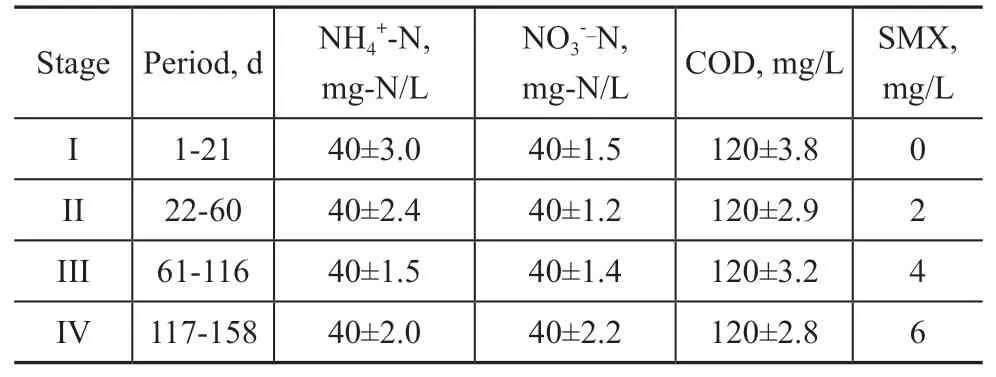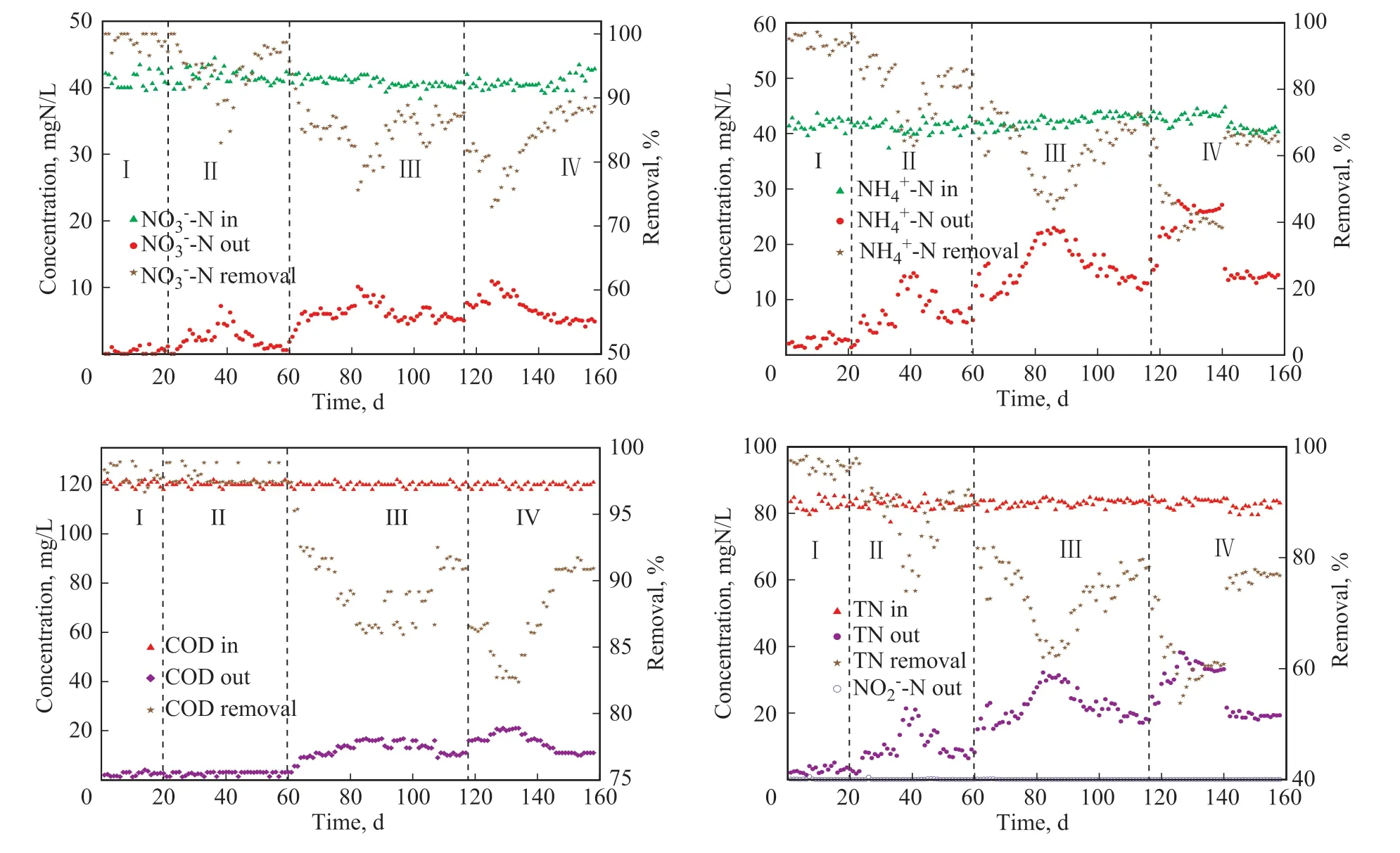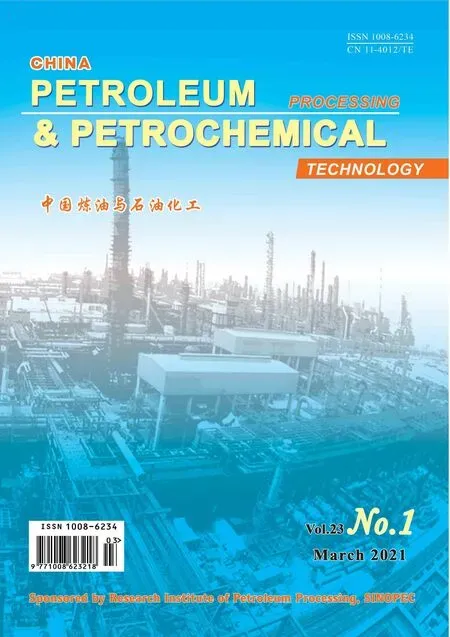Nitrogen Removal Performance of Denitrifying Ammonium Oxidation System in Treating Sulfamethoxazole-laden Secondary Wastewater Effluent
Liu Chunshuang; Li Wei; Duan Weichao; Huiyun Zhong;Yu Haitong; Li Yanze; Liu Fang; Zhao Chaocheng
(1. College of Chemical Engineering, China University of Petroleum, Qingdao 266580;2.Qingdao Oasis Environmental & Safety Technology Co., Ltd, Qingdao 266555;3. School of Environmental and Safety Engineering, Changzhou University, Changzhou, 213164)
Abstract: In this study, nitrogen removal performance of the denitrifying ammonium oxidation (DAO) process was investigated when treating sulfamethoxazole (SMX)-laden secondary wastewater effluent. The influent SMX concentration showed negligible effect on efficiencies for removal of nitrate and COD. However, the ammonium ions removal rate was moderately reduced, when the influent SMX concentration in wastewater reached 6 mg/L. Total nitrogen removal efficiency remained as high as 76.77% towards the day 158 at the end of experiment. Candidatus_Brocadia and Candidatus_Kuenenia were the functional anammox strains. The unclassified_f__Rhodobacteraceae sp. was predominant heterotrophic denitrifying strain in the studied reactor. The concentrations of soluble extracellular polymeric substances in sludge obviously increased from 16.76 mg/g VSS to 32.31 mg/g VSS, which might protect the nitrogen removal strains from high-concentration SMX. This result provides a theoretical and technical foundation for the application of denitrifying ammonium oxidation process in treating sulfamethoxazole-laden secondary wastewater effluent.
Key words: denitrifying ammonium oxidation; sulfamethoxazole; extracellular polymeric substances; total nitrogen
1 Introduction
Generally, chemical pharmaceutical industries produce antibiotics-laden wastewater with high levels of nitrogen compounds. As an example, sulfamethoxazole (SMX)production wastewater usually contains more than 10 000 mg/L of chemical oxygen demand (COD) and 500 mg/L of ammonium nitrogen (NH4+-N)[1]. Usually,COD is reduced to CH4in the anaerobic system[2].Nitrogen is supposed to be removed through nitrification and denitrification system. However, a high level of nitrate-nitrogen commonly appears in the secondary effluent with a SMX concentration of several mg/L level[3]. Advanced nitrogen removal approach should be carried out to meet the increasingly stringent standard.
Denitrifying ammonium oxidation (DAO) process could complete the advanced nitrogen removal by coupling heterotrophic denitrification and anammox[4]in one reactor. During the DAO porcess, nitrate ion is firstly reduced to nitrite ion via the heterotrophic denitrification pathway (using COD as electron donor), and then nitrite ion is converted to nitrogen gas via the anammox pathway(using ammonium nitrogen as electron donor). 81.90%of total nitrogen removal was achieved in a DAO system treating synthetic secondary effluent in a municipal wastewater plant[5].
However, the knowledge of DAO process in treating SMX-laden secondary wastewater effluent is scarce. In this study, the nitrogen removal performance of DAO process was investigated during treating secondary wastewater effluent with the SMX concentration increasing from 0 to 6 mg/L. The quantities of extracellular polymeric substances (EPS) in sludge and corresponding microbial communities of DAO consortia were reported.
2 Experimental
2.1 Reactor set-up
An UASB reactor with a dimension of 5 cm (diameter)×75 cm (height) and a working volume of 1.25 L operating at 30±1 °C, was set up. An internal reflux peristaltic pump drove an internal up-flow at a velocity of 2.0 m/s. The reactor was covered with a tin foil to protect anammox bacteria from the influence of light. Synthetic wastewater was prepared by mixing prescribed quantities of sodium acetate, potassium nitrate, sodium nitrite and sulfamethoxazole[6]. The reactor was operated in 4 stages, with the operating details presented in Table 1.Other material compositions in synthetic wastewater were prepared according to Liu’s report[6]. The inoculated sludge was a mixture of anammox sludge and denitrifying sludge (at a volume ratio of 2:1) and the initial volatile suspended solid (VSS) concentration of the inoculated sludge was 1.05 g/L.

Table 1 Operating parameters for the DAO system
2.2 Microbial community
Total genomic DNA of sludge samples was extracted from 0.15 — 0.20 g of dried sludge using the PowerSoil DNA Isolation Kit (MoBio, Carlsbad, CA, USA)following the manufacturer’s instructions. The extracted DNA amount was detected via electrophoresis with 1%of agarose gel, and its concentration was measured with a UV-Vis spectrophotometer NanoDrop 2000 (Thermo Fisher Scientific, Waltham, MA, USA). The bacterial V3-V4 region of the 16S rRNA gene was amplified using the forward primers 338F (5′-ACT CCT ACG GGA GGC AGC AG-3′) and the reverse primer 806R (5′-GGA CTA CHV GGG TWT CTA AT-3′). The detailed PCR mixture and reaction procedure can be found in the papers of Liu,et al.[7], and Shi, et al.[8]The PCR product was purified by a GeneJetPCR purification kit (Thermo Scientific)before sequencing on the Illumina Miseq PE300 platform(Illimina, USA).
2.3 Chemical analysis
After filtration by a 0.22-μm millipore filter, the NO3--N,NO2--N, and NH4+-N values in the samples were measured by an ion chromatography instrument equipped with a thermal type conductivity detector and an Ionpac column(ICS-3000; Dionex, USA). The pH value of the liquid samples, the suspended solids (SS), and the volatile suspended solids of the sludge were measured by standard methods[9]. Soluble extracellular polymeric substances were extracted from 25 mL of sludge at the end of each operation stage by centrifugation method[10]. The protein(PN) and polysaccharides (PS) quantities in soluble EPS were measured using the Lowry method with bovine serum albumin acting as standard and the Anthrone method with glucose acting as standard, respectively[10].
3 Results and Discussion
3.1 Performance of the denitrifying ammonium oxidation reactor
The reactor was operated for 158 days, including 4 stages (Stage I to Stage IV) according to the influent concentration of SMX. The nitrogen removal performance is illustrated in Figure 1. At Stage I, the influent concentration of SMX was 0 mg/L. The averaged effluent concentrations of nitrate, ammonium ions and COD were 1.16 mgN/L, 1.97 mgN/L, and 2.4 mg/L,respectively, and the corresponding removal rates were 97.1%, 95.07%, and 98%, respectively. The averaged TN removal efficiency was as high as 97.02%, indicating the efficient nitrogen removal effect of the DAO reactor.
On day 22, the influent concentration of SMX was changed to 2 mg/L (Stage II). The COD removal efficiency was maintained at more than 97.02%. Removal efficiencies of nitrate and ammonium ions slightly decreased to 93.60% and 84.29%, respectively. The averaged TN removal efficiency decreased to 90.20%and the effluent TN concentration was 7.84 mg/L. This phenomenon indicated that 2 mg/L of SMX had a slight inhibition effect on the activity of anammox bacteria.The influent SMX concentration further increased to 4 mg/L at Stage III. Removal efficiencies of nitrate,COD, and ammonium ions firstly decreased to 79.71%,85.21%, and 43.95%, respectively, and then increased to 87.69%, 90.20%, and 70.39%, respectively, indicating the acclimation of functional bacteria to SMX. The TN removal at first decreased to 62.34% and then recovered to 78.3%. The averaged effluent TN concentration increased to 17.36 mg/L at this stage.

Figure 1 Performance of DAO reactor at different stages
On day 117, the influent SMX concentration increased to 6 mg/L (Stage IV). Changes in removal rate of nitrate,COD, and ammonium ions were similar to that measured at Stage III. Removal efficiencies of nitrate, COD, and ammonium ions firstly declined to 72.97%, 82.31%,and 34.58% and then increased to 87.77%, 90.20%, and 64.22%, respectively. The corresponding TN removal primarily decreased to 53.76% and then recovered to 76.77% towards the end of the experiment. The above results suggest that the DAO process can maintain a relatively efficient nitrogen removal performance for treating the SMX-laden secondary wastewater effluent.
3.2 EPS at different SMX concentration
The compositions of the soluble EPS (PN and PS) in the sludge under different SMX concentration condition are listed in Table 2. The quantity of soluble EPS was obviously enhanced with the increase of influent SMX concentration and reached 32.31 mg/gVSS at the end of experiment. The PN and PS in EPS both doubled from 4.08 mg/gVSS (Stage I) to 8.31 mg/gVSS (Stage IV)and increased from 12.68 mg/gVSS to 24.00 mg/gVSS,respectively. It was reported that SMX could bind with EPS when both were at high concentrations,minimizing SMX’s inhibition effects on functional bacteria[11]. This could also explain the results in Figure 1 that the performance of DAO reactor did not decrease proportionally with SMX’s increase. SMX’s effects on the bacteria could have been compromised by the high EPS amount gradually, leading to the recovery of the removal efficiencies in Stage III and Stage IV as depicted in Figure 1.

Table 2 EPS contents at different stages
3.3 Microbial communities
The parameters related to the alpha diversity of microbial community for each sample at an increment of 0.03 are shown in Table 3. The species richness for bacteria in the reactor varied significantly during 158-day operation,which was revealed by OTUs and Chao 1. This is confirmed by the coverage values of four samples,indicating that almost all OTUs in the reactor were detected in this study.
In total, eight known bacterial phyla were detected in the four samples, including Planctomycetes, Chloroflexi,Proteobacteria, Actinobacteria, Ignavibacteriae,Acidobaacteria, Bacteroidetes, and Armatimonadetes(Figure 2). Chloroflexi and Proteobacteria predominated in all communities.
The phyla Planctomycetes, Chloroflexi, Proteobacteria,and Ignavibacteriae were identified as dominant at Stage I. The abundances of Planctomycetes and Ignavibacteriae gradually decreased from 27.79% and 8.98% (Stage I)to 9.49% and 3.46% (Stage IV), respectively. On the contrary, the corresponding abundance of Chloroflexi,Proteobacteria, Actinobacteria, and Bacteroidetes gradually increased from 22.18%, 17.78%, 5.56%, and 1.06% (Stage I) to 28.73%, 27.77%, 7.39%, and 4.86%(Stage IV), respectively. The abundance of Acidobacteria and Armatimonadetes had little change and remained at around 3.46% and 1.49%, respectively, during the whole process.
A wide range of bacteria genera were identified as dominant at Stage I, such as unclassified_f__Rhodobacteraceae, norank_f__unclassified_Rhizobiales,Pseudoxanthomonas, Thermomonas, Candidatus_Brocadia, Candidatus_Kuenenia, norank_c_unclassified_Chloroflexi,unclassified_Anaerolinaeaceae, norank_p_unclassified_Bacteria,unclassified_k_norank_d_Bacteria, Candidatus_Kuenenia,unclassified_Ignavibacteriaceae, Norank_f_unclaffified_Nurkholderiales, Litorilinea, Igvavibacterium,unclassified_f_lamiaceae, norank_f_unclassified_Rhizobiales,unclassified_Sphaerobacteraceae,norank_c_unclassified_Actinobacteria,ulclassified_f_Polyangiaceae, Gp16, Gordonia, Armatimonadetes_gp5, Gp10, Acinetobacter, Llumatobacter,unclassified_Planctomycetaceae, norank_c_uclassified_Bacteroidetes,andunclassified_Comamonadaceae(Figure 3).

Figure 2 Taxonomic classification of the bacterial communities at phylum level

Table 3 Richness and diversity of the four samples based on 0.03 distance

Figure 3 Taxonomic classification of the bacterial communities at genus level
Six genera, including unclassified_f__Rhodobacteraceae,norank_f__unclassified_Rhizobiales, Pseudoxanthomonas,Thermomonas, Candidatus_Brocadia,andCandidatus_Kueneniaare the typical functional bacteria in the DAO system. Unclassified_f__Rhodobacteraceae, norank_f_unclassified_Rhizobiales, Pseudoxanthomonas,andThermomonasare typical heterotrophic denitrification bacteria, which could utilize organic carbon as the electron donor to reduce nitrate into nitrite or nitrogen gas[12-14].Candidatus_Brocadia[15]andCandidatus_Kuenenia[16]are typical anammox bacteria, which have been detected in many anaerobic ammonium oxidation reactors.
The abundance ofunclassified_f__Rhodobacteraceaefirstly increased from 1.12% to 2.03% with the influent SMX concentration increasing from 0 (Stage I) to 2 mg/L (Stage II), and then dramatically decreased to 0.79%at Stage III. With the influent SMX concentration further increasing to 6 mg/L (Stage IV), the abundance of unclassified_f__Rhodobacteraceaeincreased to 4.83%.In contrast, the abundance value showed little change innorank_f_unclassified_Rhizobiales,Pseudoxanthomonas,andThermomonasduring the whole process.
The generaCandidatus_BrocadiaandCandidatus_Kueneniadecreased dramatically from 20.19% and 5.43%to 8.85% and 0.37%, respectively, with the influent SMX concentration increasing from 0 (Stage I) to 6 mg/L (Stage IV). This result indicated that the activity of anammox bacteria could be moderately inhibited by 6 mg/L of SMX.
4 Conclusions
Higher TN removal efficiency (>76.77%) was achieved in DAO system when influent SMX concentration varied in the range of 0—6 mg/L.Candidatus_Brocadia,Candidatus_Kueneniaandunclassified_f__Rhodobacteraceaewere functional strains for anammox and denitrification process,respectively, in the reactor. The quantities of soluble EPS in sludge increased obviously from 16.76 mg/g VSS to 32.31 mg/g VSS during the experimental process, which might provide protection to the functional strains on performing nitrogen removal reactions.
Acknowledgements:This research was supported by the Natural Science Foundation of Shandong Province(ZR2019MEE038), the Fundamental Research Funds for the Central Universities (19CX02038A).
- 中國煉油與石油化工的其它文章
- Preparation and Rheological Properties of Vacuum Lubricating Grease
- Effects of Different Plant Hormones for Microbial Degradation of PASHs and Diesel under Aerobic Conditions
- Removal of Basic Nitrogen Compounds from Diesel Fraction with NMP-0.5ZnCl2 Coordinated Ionic Liquid
- Flow Characteristics of Crude Oil with High Water Fraction during Non-heating Gathering and Transportation
- Comparison and Analysis of Toluene Adsorption Properties of ZSM-5 Molecular Sieve Treated by Different Modification Methods: Adsorption Kinetic and Mechanism Studies
- Effects of Operating Conditions on the Catalytic Performance of HZSM-5 Zeolites in n-Pentane Cracking

